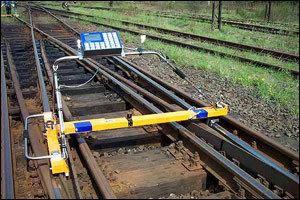Rail Gauge Distances
The standard rail gauge distance is 1,435 mm. This measurement is used by  nearly 60% of railways in the world. However, there are also broad, narrow and minimum gauges.
nearly 60% of railways in the world. However, there are also broad, narrow and minimum gauges.
Most Often Used Gauges
The Indian gauge is 1,676 mm (5 ft 6 in). It is used mostly in India, Pakistan and Chile. The Iberian gauge is 1,668 mm (5 ft 5 2/⁄3 in) and is employed in Portugal and Spain. The Irish gauge is 1,600 mm (5 ft 3 in) and utilized in Australia, Brazil and Ireland.
The Russian gauge is 1,524 mm (5 ft). It is also used in Estonia and Finland. There is another Russian gauge measuring 1,520 mm (4 ft 11 5/6 in). It is employed in Russia, Lithuania, Latvia and other countries. This rail gauge distance is used in 17% of the railways on the planet.
The standard rail gauge is 1,435 mm (4 ft 8 1/2 in). It is utilized in Europe, the United States, Canada and many countries in the Middle East. This gauge is also used in Mexico, Panama, Cuba, Australia, the Philippines, Uruguay and many other nations.
9% of the railways in the world use the Cape gauge, which is 1,067 mm (3 ft 6 in). The meter is 1,000 mm (3 ft 3 3/8 in) and is used in some Southeast Asia countries and India.
Broad Gauges
This rail gauge distance includes the Indian gauge, the Iberian gauge, the Irish gauge and the imperial and metric Russian gauge.
Uncommon Gauges (in mm)
These include the 2,140 gauge that was used in Brunei until 1972. The 2,000 gauge is used by the Cairngorm Mountain Railway in the UK while the 1,980 gauge is used in the Carmelit subway railway line in Israel.
The 1,945 gauge was used in the Netherlands until 1866 and the 1,880 gauge was used by the Ulster Railway in Ireland from 1839–1846. The 1,750 gauge was employed in the line from Limours to Paris but was discontinued in 1891.
The Medium Gauge (Metric)
This rail gauge distance refers to any measurement over 1,000 mm and less than the Standard Gauge. Among them are the 1,422 gauge used in the UK and the US, the 1,384 and 1,416 gauge utilized in Scotland and the 1,372 gauge in Japan. The 1,245 is still being utilized in England; the 1,219 gauge is still used in Wales, England and New Zealand.
In Sweden the gauge used is 1,217 mm. In Austria it is 1,106; the 1,100 gauge is used in Brazil and Italy while the 1055 gauge is employed in Algeria. In Lebanon and Syria, the medium gauge being used is 1,050.
Narrow Gauge
These are gauges over 578 mm and under 1000 mm. The 914 narrow gauge is used in Australia, Canada, Guatemala, Ireland and other countries. The 900 mm narrow gauge is used in Linz tramways in Austria and New Athos Cave Railway in Georgia.
The rail gauge distances used in the world are likely to be standardized in the future. The reason is that interconnecting railways are becoming necessary.





